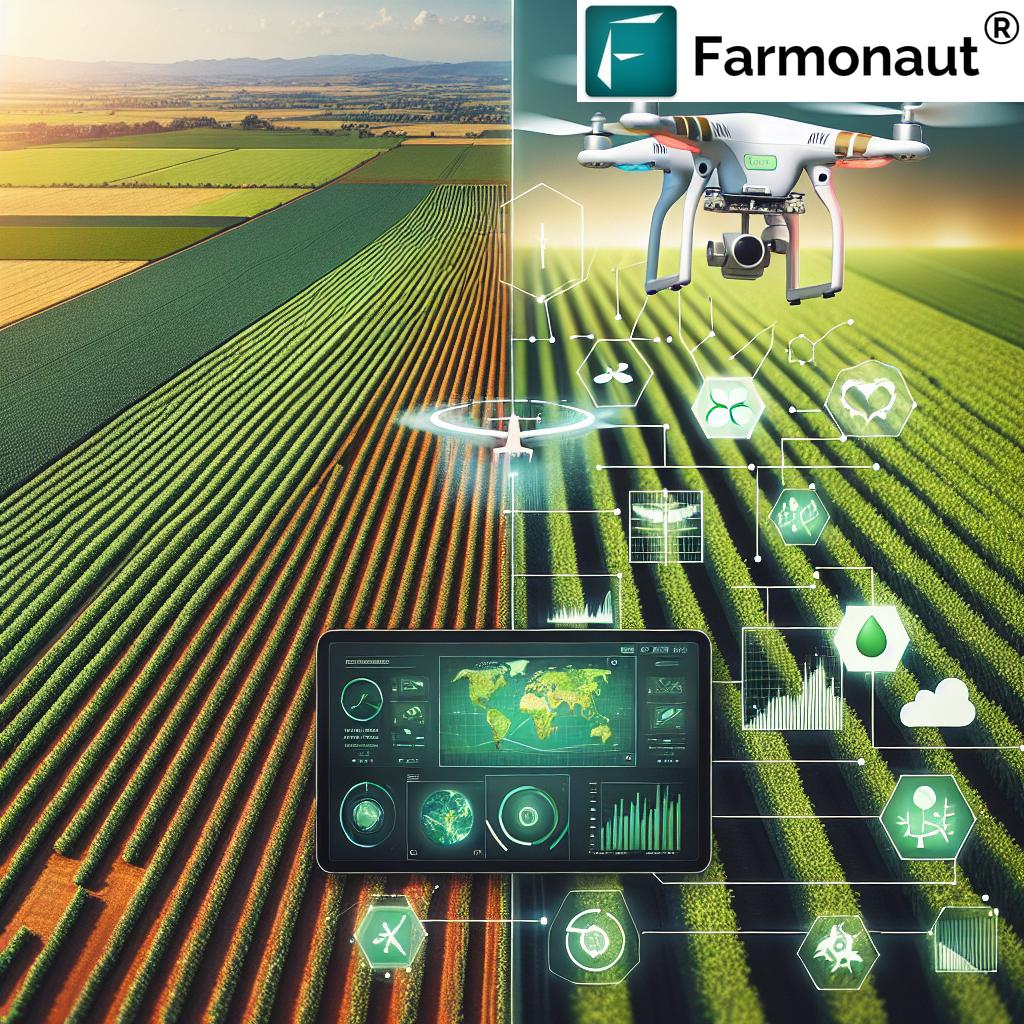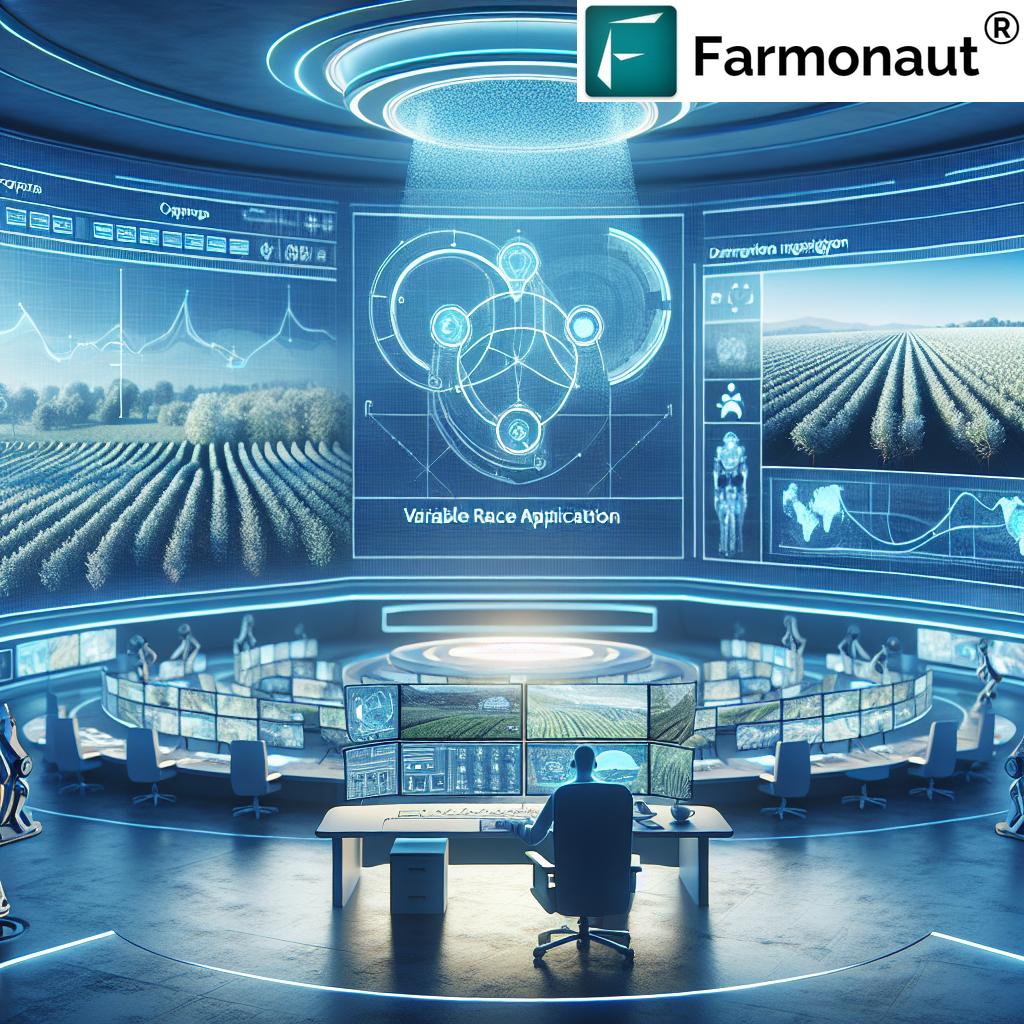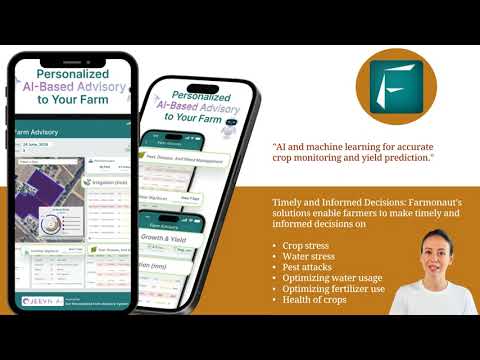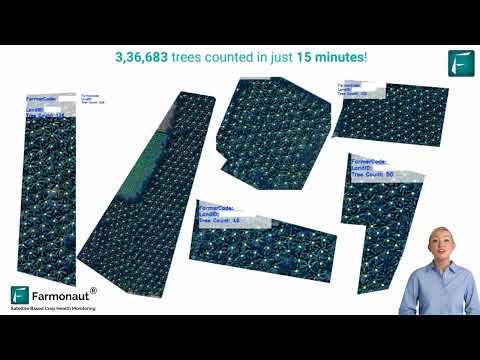Revolutionizing Precision Agriculture: How Satellite Crop Monitoring and Data Analytics Boost Sustainable Farming
In today’s rapidly evolving agricultural landscape, we find ourselves at the forefront of a technological revolution that is transforming the way we approach farming. The integration of satellite crop monitoring and advanced data analytics into agricultural practices is ushering in a new era of precision agriculture, one that promises to enhance productivity, sustainability, and resource efficiency on a global scale.

As we delve into this exciting realm of agricultural innovation, we’ll explore how cutting-edge technologies are revolutionizing farming practices, driving sustainability, and addressing some of the most pressing challenges facing the agricultural industry today.
The Rise of Precision Agriculture
Precision agriculture represents a paradigm shift in farming methodology. By leveraging advanced technologies such as satellite imagery, remote sensing, and data analytics, farmers can now make informed decisions based on real-time, highly accurate information about their crops and land. This approach allows for targeted interventions, optimized resource use, and improved yield predictions.
Key components of precision agriculture include:
- Satellite crop monitoring
- Agricultural data analytics
- Remote sensing technologies
- Geospatial intelligence
- Variable Rate Application (VRA)
- Crop management solutions
These technologies work in synergy to provide farmers with unprecedented insights into their operations, enabling them to make data-driven decisions that enhance productivity while minimizing environmental impact.
Satellite Crop Monitoring: A Game-Changer for Modern Farming
At the heart of precision agriculture lies satellite crop monitoring, a revolutionary technology that has transformed the way we observe and manage agricultural lands. By harnessing the power of Earth observation satellites, we can now gather crucial data about crop health, soil moisture, and environmental conditions across vast areas with remarkable accuracy and frequency.
Benefits of satellite crop monitoring include:
- Real-time crop health assessment
- Early detection of pest infestations and diseases
- Accurate yield prediction
- Efficient resource allocation
- Improved irrigation management
- Enhanced decision-making capabilities
These advantages collectively contribute to more sustainable farming practices, reduced environmental impact, and increased profitability for farmers.
Agricultural Data Analytics: Turning Information into Actionable Insights
The true power of satellite crop monitoring is unleashed when combined with advanced data analytics. By processing and analyzing the vast amounts of data collected from satellites, drones, and ground sensors, we can extract valuable insights that drive informed decision-making in agriculture.
Key applications of agricultural data analytics include:
- Crop classification algorithms
- Yield prediction technology
- Soil moisture analysis
- Field boundary detection
- Harvest monitoring systems
- Climate change impact assessment
These analytical tools enable farmers to optimize their operations, reduce waste, and adapt to changing environmental conditions with greater agility.
Sustainable Farming Practices: The Role of Precision Agriculture
As the global population continues to grow and climate change threatens food security, the importance of sustainable farming practices cannot be overstated. Precision agriculture plays a crucial role in promoting sustainability by enabling more efficient use of resources and minimizing environmental impact.
Ways in which precision agriculture contributes to sustainability:
- Reduced water usage through targeted irrigation
- Minimized chemical inputs via precise application
- Decreased soil erosion through optimized land management
- Lower carbon emissions due to efficient machinery use
- Enhanced biodiversity through targeted conservation efforts
By adopting these practices, farmers can not only improve their yields and profitability but also contribute to global efforts in combating climate change and preserving natural resources.

Geospatial Intelligence in Agriculture
Geospatial intelligence is revolutionizing the agricultural sector by providing comprehensive, location-based insights that inform decision-making at every level of farm management. By integrating data from multiple sources, including satellites, drones, and ground sensors, geospatial intelligence offers a holistic view of agricultural operations.
Applications of geospatial intelligence in farming include:
- Precision mapping of crop health and yield potential
- Identification of optimal planting and harvesting times
- Detection of pest and disease outbreaks
- Assessment of soil quality and nutrient levels
- Monitoring of weather patterns and climate trends
These capabilities enable farmers to make more informed decisions, leading to improved crop management and increased overall farm productivity.
Crop Management Solutions: Integrating Technology for Optimal Results
Modern crop management solutions leverage a combination of satellite data, IoT devices, and advanced analytics to provide comprehensive farm management tools. These integrated platforms offer farmers a centralized system for monitoring and managing all aspects of their operations.
Key features of advanced crop management solutions:
- Real-time crop health monitoring
- Automated alerts for potential issues
- Customized recommendations for fertilizer and pesticide application
- Integration with farm machinery for precision operations
- Data-driven yield forecasting
- Historical data analysis for long-term planning
By adopting these solutions, farmers can streamline their operations, reduce costs, and maximize yields while minimizing environmental impact.
Variable Rate Application (VRA): Precision in Resource Management
Variable Rate Application (VRA) technology is a cornerstone of precision agriculture, allowing farmers to apply inputs such as water, fertilizers, and pesticides with unprecedented accuracy. By tailoring the application of resources to the specific needs of each area within a field, VRA significantly improves efficiency and reduces waste.
Benefits of VRA technology:
- Optimized use of agricultural inputs
- Reduced environmental impact
- Improved crop quality and yield
- Cost savings on resources
- Enhanced soil health through targeted applications
The adoption of VRA technology is a key step towards more sustainable and efficient farming practices, aligning perfectly with the goals of precision agriculture.
Remote Sensing in Agriculture: Beyond Satellite Imagery
While satellite imagery plays a crucial role in precision agriculture, remote sensing technologies extend beyond space-based observations. Drones, aircraft, and ground-based sensors complement satellite data, providing a multi-layered approach to agricultural monitoring.
Key remote sensing technologies in agriculture:
- Multispectral and hyperspectral imaging
- LiDAR for 3D mapping of crops and terrain
- Thermal imaging for water stress detection
- Ground-penetrating radar for soil analysis
- IoT sensors for real-time environmental monitoring
The integration of these diverse remote sensing technologies provides farmers with a comprehensive understanding of their crops and land, enabling more precise and effective management strategies.
Agricultural Drone Technology: A Closer Look at Crop Health
Agricultural drones have emerged as a powerful tool in precision farming, offering high-resolution imagery and data collection capabilities that complement satellite-based monitoring. These unmanned aerial vehicles provide farmers with on-demand, detailed insights into crop health, pest infestations, and field conditions.
Applications of agricultural drone technology:
- High-resolution crop mapping
- Plant health assessment using multispectral cameras
- Targeted spraying of pesticides and fertilizers
- Livestock monitoring and management
- Irrigation system inspection
- Crop damage assessment for insurance claims
The flexibility and precision offered by drone technology make it an invaluable asset in modern precision agriculture, enabling farmers to respond quickly to emerging issues and optimize their operations.
Farm Management Platforms: Centralizing Agricultural Intelligence
Farm management platforms serve as the central nervous system of precision agriculture operations, integrating data from various sources and providing farmers with a unified interface for decision-making. These platforms leverage cloud computing and mobile technologies to offer accessible, real-time insights into farm operations.
Key features of modern farm management platforms:
- Integration of satellite, drone, and sensor data
- Customizable dashboards for at-a-glance insights
- Task management and scheduling tools
- Financial planning and budgeting modules
- Compliance and record-keeping functionalities
- Mobile apps for on-the-go management
By centralizing farm management tasks and data, these platforms empower farmers to make informed decisions quickly and efficiently, leading to improved productivity and profitability.
Soil Moisture Analysis: The Foundation of Effective Crop Management
Accurate soil moisture analysis is crucial for optimal crop growth and efficient water management. Precision agriculture technologies offer advanced methods for monitoring and analyzing soil moisture levels, enabling farmers to make informed decisions about irrigation and crop management.
Technologies for soil moisture analysis:
- Satellite-based soil moisture mapping
- In-situ soil moisture sensors
- Drone-based thermal imaging
- Ground-penetrating radar
- Advanced data analytics for moisture prediction
By leveraging these technologies, farmers can optimize irrigation schedules, reduce water waste, and improve crop resilience to drought conditions.
Crop Classification Algorithms: Enhancing Agricultural Intelligence
Crop classification algorithms are a cornerstone of precision agriculture, enabling the automatic identification and mapping of different crop types across large areas. These advanced machine learning techniques analyze satellite imagery and other remote sensing data to provide accurate, up-to-date information on crop distribution and health.
Applications of crop classification algorithms:
- Large-scale crop inventory and monitoring
- Early detection of crop diseases and pests
- Yield estimation and forecasting
- Land use change detection
- Agricultural policy planning and implementation
The insights provided by these algorithms are invaluable for farmers, policymakers, and agricultural researchers, supporting better decision-making at all levels of the agricultural sector.
Harvest Monitoring Systems: Optimizing the Final Stage
Harvest monitoring systems represent the culmination of precision agriculture techniques, providing farmers with real-time data and insights during the critical harvesting phase. These systems integrate various technologies to optimize harvest timing, reduce losses, and improve overall crop quality.
Components of advanced harvest monitoring systems:
- Yield mapping technology
- Real-time moisture sensors
- Automated harvester guidance systems
- Quality assessment tools
- Predictive analytics for optimal harvest scheduling
By implementing these systems, farmers can maximize their harvest efficiency, reduce post-harvest losses, and ensure the highest quality produce reaches the market.
Agricultural Sustainability Solutions: Balancing Productivity and Conservation
As the global agricultural industry faces increasing pressure to meet growing food demands while minimizing environmental impact, sustainability solutions have become paramount. Precision agriculture technologies offer a range of tools and practices that promote sustainable farming while maintaining or even improving productivity.
Key agricultural sustainability solutions:
- Precision irrigation systems for water conservation
- Targeted application of inputs to reduce chemical use
- Soil health monitoring and management
- Carbon sequestration tracking and optimization
- Biodiversity preservation through precision land management
- Energy-efficient farming practices
These solutions not only contribute to environmental conservation but also often result in cost savings and improved long-term farm viability.
Agtech Innovations: The Future of Farming
The field of agricultural technology (agtech) is rapidly evolving, with new innovations constantly emerging to address the challenges faced by modern farmers. These cutting-edge technologies are shaping the future of agriculture, promising even greater efficiencies and sustainability in the years to come.
Emerging agtech innovations:
- AI-powered crop management systems
- Blockchain for agricultural supply chain transparency
- Gene editing for crop resilience and yield improvement
- Autonomous farming robots and machinery
- Vertical farming and controlled environment agriculture
- Precision livestock farming technologies
As these innovations continue to develop and integrate with existing precision agriculture practices, we can expect to see even more dramatic improvements in agricultural productivity, sustainability, and resource efficiency.
Comparative Analysis: Traditional Farming vs. Satellite Crop Monitoring
| Aspect | Traditional Farming Methods | Satellite Crop Monitoring |
|---|---|---|
| Crop Health Assessment | Visual inspection, time-consuming and subjective | Real-time NDVI analysis, objective and comprehensive |
| Irrigation Scheduling | Based on experience and manual checks | Data-driven, using soil moisture analysis and weather forecasts |
| Yield Prediction | Rough estimates based on historical data | Advanced analytics with up to 95% accuracy |
| Pest Detection | Regular field scouting, often reactive | Early detection through spectral analysis, proactive approach |
| Resource Optimization | Uniform application across fields | Variable Rate Application, 20% increase in efficiency |
| Environmental Impact | Higher water and chemical usage | 15% reduction in water use, 20% reduction in pesticide application |
| Decision Making | Intuition and experience-based | Data-driven insights for informed decisions |
| Scalability | Limited by manual processes | Highly scalable across large areas |
| Cost Efficiency | Higher labor costs, potential for waste | Reduced labor needs, optimized input use |
| Sustainability | Challenging to implement precision conservation | Enables targeted sustainability practices |
The Role of GIS in Precision Agriculture
Geographic Information Systems (GIS) play a crucial role in precision agriculture, providing the foundational technology for integrating, analyzing, and visualizing spatial data. GIS enables farmers and agricultural managers to make informed decisions based on location-specific information.
Key applications of GIS in agriculture:
- Creation of detailed farm maps
- Spatial analysis of crop yield data
- Integration of multiple data layers (soil, climate, topography)
- Route optimization for farm machinery
- Risk assessment and management
- Land use planning and management
By leveraging GIS technologies, farmers can gain a comprehensive understanding of their land and crops, leading to more efficient and sustainable farming practices.
Deep Learning in Agricultural Image Processing
Deep learning algorithms are revolutionizing the way we process and analyze agricultural imagery. These advanced AI techniques can extract valuable insights from satellite, drone, and ground-based imagery with unprecedented accuracy and speed.
Applications of deep learning in agricultural image processing:
- Automated crop type identification
- Disease and pest detection
- Weed mapping and management
- Yield estimation from aerial imagery
- Soil quality assessment
- Phenotyping for plant breeding programs
The integration of deep learning technologies into precision agriculture workflows is enhancing our ability to monitor and manage crops at scale, leading to improved decision-making and resource allocation.
The Global Impact of Precision Agriculture
Precision agriculture technologies are not limited to any single region or country; their impact is truly global. From small-scale farmers in developing nations to large agricultural corporations in industrialized countries, the benefits of these technologies are being realized worldwide.
Global applications of precision agriculture:
- Improving food security in developing regions
- Enhancing agricultural productivity in established farming areas
- Supporting sustainable development goals (SDGs)
- Facilitating climate-smart agriculture practices
- Promoting responsible consumption and production
- Enabling precision conservation efforts
As these technologies continue to evolve and become more accessible, their potential to address global agricultural challenges and contribute to sustainable development will only increase.
The Role of Satellite Constellations in Agricultural Monitoring
The advent of satellite constellations has dramatically increased the frequency and resolution of Earth observation data available for agricultural monitoring. These networks of small satellites provide near-real-time imagery and data, enabling more timely and accurate agricultural insights.
Benefits of satellite constellations for agriculture:
- Daily or even sub-daily imaging capabilities
- Improved spatial and temporal resolution
- Reduced cloud cover issues through frequent revisits
- Combination of optical and radar imaging for comprehensive monitoring
- Global coverage, including remote and inaccessible areas
- Cost-effective data acquisition for large-scale monitoring
The increasing availability of data from satellite constellations is driving innovation in agricultural monitoring and management practices, making precision agriculture more accessible and effective than ever before.
The Intersection of Precision Agriculture and Climate Change Mitigation
Precision agriculture technologies are playing an increasingly important role in efforts to mitigate and adapt to climate change. By optimizing resource use and promoting sustainable practices, these technologies contribute to reducing agriculture’s environmental footprint while enhancing resilience to changing climate conditions.
Climate-related applications of precision agriculture:
- Carbon sequestration monitoring and optimization
- Reduction of greenhouse gas emissions through efficient farming practices
- Adaptation to changing precipitation patterns through precision irrigation
- Crop variety selection based on climate projections
- Early warning systems for extreme weather events
- Monitoring and management of climate-related pest and disease outbreaks
By leveraging these technologies, the agricultural sector can play a significant role in global efforts to combat climate change while ensuring food security for a growing population.
The Future of Precision Agriculture: Emerging Trends and Technologies
As we look to the future, several emerging trends and technologies are poised to further revolutionize precision agriculture. These innovations promise to enhance the accuracy, efficiency, and sustainability of farming practices.
Emerging trends in precision agriculture:
- Integration of 5G technology for real-time data transmission
- Advanced edge computing for on-farm data processing
- Quantum computing applications in complex agricultural modeling
- Augmented and virtual reality tools for farm management
- Nanotechnology for precision nutrient delivery and pest control
- Synthetic biology for enhanced crop traits and resilience
As these technologies mature and become more widely adopted, we can expect to see continued improvements in agricultural productivity, sustainability, and resilience to environmental challenges.
Frequently Asked Questions (FAQ)
Q: What is precision agriculture?
A: Precision agriculture is an approach to farm management that uses information technology and a wide array of items such as GPS guidance, control systems, sensors, robotics, drones, autonomous vehicles, variable rate technology, GPS-based soil sampling, automated hardware, telematics, and software to optimize returns on inputs while preserving resources.
Q: How does satellite crop monitoring work?
A: Satellite crop monitoring uses images captured by Earth observation satellites to assess various aspects of crop health and field conditions. These satellites use multispectral sensors to capture data across different wavelengths of light, which can be analyzed to determine factors such as crop health, soil moisture, and potential pest or disease outbreaks.
Q: What are the main benefits of using precision agriculture technologies?
A: The main benefits include increased crop yields, reduced input costs (such as water, fertilizers, and pesticides), improved environmental sustainability, better decision-making through data-driven insights, and enhanced ability to adapt to changing climate conditions.
Q: How does precision agriculture contribute to sustainability?
A: Precision agriculture promotes sustainability by optimizing resource use, reducing waste, minimizing environmental impact through targeted application of inputs, and enabling better land management practices. It also helps in reducing greenhouse gas emissions and promoting soil health.
Q: Is precision agriculture only for large-scale farms?
A: While initially more prevalent in large-scale operations, precision agriculture technologies are becoming increasingly accessible to small and medium-sized farms. Many solutions are scalable and can be adopted incrementally, allowing farmers of all sizes to benefit from these technologies.
Q: How accurate are yield prediction technologies in precision agriculture?
A: Yield prediction technologies have become increasingly accurate, with some advanced systems achieving accuracy rates of over 90%. However, the accuracy can vary depending on factors such as the specific crops, environmental conditions, and the quality and quantity of data available.
Q: What role does artificial intelligence play in precision agriculture?
A: Artificial intelligence, particularly machine learning and deep learning algorithms, plays a crucial role in analyzing the vast amounts of data generated in precision agriculture. AI helps in pattern recognition, predictive modeling, and automated decision-making, enhancing the efficiency and effectiveness of agricultural management practices.
Q: How can farmers get started with precision agriculture?
A: Farmers can start by adopting basic precision agriculture tools such as GPS-guided machinery or simple soil sensors. As they become more comfortable with the technology, they can gradually incorporate more advanced solutions like satellite crop monitoring or variable rate application systems. It’s often beneficial to start with a specific problem or goal and choose technologies that address that particular need.
Q: What are the challenges in implementing precision agriculture?
A: Common challenges include initial investment costs, the need for technical expertise, data management and integration issues, and ensuring reliable connectivity in rural areas. Additionally, there can be challenges related to data privacy and security, as well as the need for ongoing training and support.
Q: How does precision agriculture impact food security?
A: Precision agriculture contributes to food security by increasing crop yields, improving resource efficiency, and enhancing the resilience of farming systems to environmental stresses. By optimizing production and reducing waste, these technologies help ensure a more stable and abundant food supply to meet the needs of a growing global population.
Conclusion: The Future of Farming is Precision-Driven
As we’ve explored throughout this comprehensive overview, the integration of satellite crop monitoring and data analytics into agricultural practices is revolutionizing the way we approach farming. Precision agriculture technologies offer unprecedented opportunities to enhance productivity, sustainability, and resource efficiency in the agricultural sector.
From satellite-based crop monitoring and advanced data analytics to the use of drones, IoT devices, and AI-powered management systems, these innovations are empowering farmers to make more informed decisions, optimize their operations, and adapt to changing environmental conditions. The result is a more resilient, sustainable, and productive agricultural industry that is better equipped to meet the challenges of feeding a growing global population while minimizing environmental impact.
As these technologies continue to evolve and become more accessible, we can expect to see even greater advancements in precision agriculture. The future of farming is undoubtedly precision-driven, and by embracing these innovations, we can work towards a more sustainable and food-secure world for generations to come.
To learn more about how you can leverage these cutting-edge technologies in your farming operations, explore the solutions offered by Farmonaut:
For developers interested in integrating Farmonaut’s powerful satellite and weather data into their own applications, check out our API and API Developer Docs.
“Satellite crop monitoring can increase farm productivity by up to 20% through precise resource management and timely interventions.”
“Advanced crop classification algorithms can achieve accuracy rates of over 95% in identifying different crop types from satellite imagery.”






